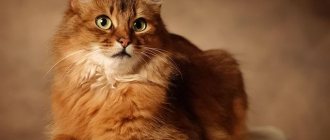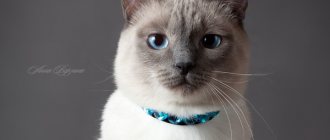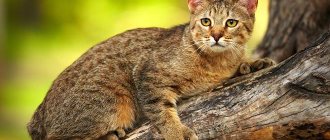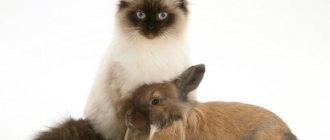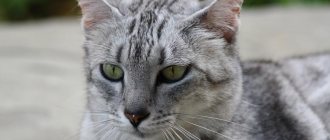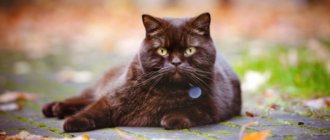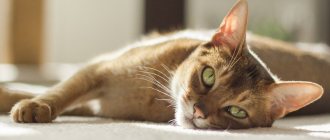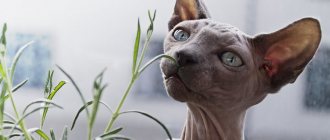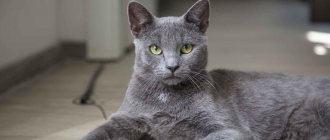Home » Breeds » About the Peterbald cat breed
The Peterbald or St. Petersburg Sphynx, like no other breed of hairless cat, resembles alien creatures with its exotic appearance: quite large, with long limbs, skin gathered into frequent folds, which is clearly too large for the animal, a long whip-like strong tail, huge ears and bulging almond-shaped simply unimaginable eyes, devoid of eyelashes
For those who have not seen “hairless” cats before meeting the Peterbald, the sight of such a pet can cause a short shock, which is why it is strongly recommended to get to know them better!
Origin story
Peterbald - sheer elegance and grace - was bred by Russian breeders relatively recently: in 1994. So their story is simple and has no centuries-old mystery. The second name of the Peterbald is the St. Petersburg Sphinx.
This, so to speak, is a 100% selective “product” resulting from the mixing of two well-known breeds: the Don Sphynx of Afinogen and the oriental cat Radma. The first experiment was carried out in 1994 by felinologists from St. Petersburg Tatyana Komarova and Olga Mironova.
In the first two litters, the original kittens were selected: Nocturne, Nezhenka, Muscat and Mandarin. From their father they adopted the lack of fur and the shape of the body, and from their mother - their Asian character. The kittens were included in the stud books and they became the first officially recognized ancestors of the currently existing Peterbalds.
The new breed quickly gained universal recognition. Permission for breeding was given by the Selective Felinological Federation (in 1996), soon the International Cat Association joined it (giving the breed the abbreviation PD), and finally, the animals were recognized by the World Cat Federation (2003).
At the moment, matings between “Petersburgers” and Don Sphynxes are prohibited. Feline specialists pay more attention to the external characteristics of the breed, but they do not plan to breed exclusively “hairless” cats. Maximum breed traits from Orientals and Siamese - that is their task.
“Peterbald” consists of two words: “peter” - Peter and “bold” - bald. As the breeder Olga Mironova explains, the name was invented thanks to the monument to Peter the Great (authored by Shemyakin): the first All-Russian Emperor is compared to a hidden, wary cat.
Despite the keen interest in the breed among cat people and constant participation in European exhibitions, few Peterbalds have been bred so far.
Kitten price
It is necessary to purchase a kitten only from professional nurseries at least three months old. A veterinary passport is required. Today, the sale of the St. Petersburg Sphynx is carried out by numerous breeders from different cities of Russia.
The cost of an animal varies widely depending on the purpose of purchase. You can buy a Neva Sphynx as a pet for ten thousand rubles. The price of a pet for professional breeding or exhibition work will be significantly higher.
Photo gallery of Peterbald and some other types of sphinxes:
1111
Standards
The appearance of Peterbalds is more refined and graceful than that of Sphynxes. The latter weigh 5-7 kg, while Peterbalds weigh a maximum of 5.
| Standard | Description |
| Head | Wedge-shaped, with a long and narrow muzzle. The profile is slightly convex, the forehead is flat. |
| Nose | Straight, long. |
| Eyes | Set obliquely, almond-shaped. The color of the iris is most often green, but blue is also allowed for the point color. They are spaced widely (according to the standard, one more eye can fit between them). |
| Body | Muscular and long, the silhouette is graceful. Same neck. The chest is narrower than the hips. |
| Paws | Long and thin, straight, lean. The front ones are slightly shorter than the rear ones. The pads are oval, elastic, the fingers are flexible (“monkey”). |
| Tail | Long and thin, the tip is pointed, whip-like. |
| Vibrissae | Broken-crimped or completely absent. |
| Ears | Large and tall, set wide apart, protruding beyond the cheek line. The tips are pointed. |
| Leather | Soft, forms numerous folds. There are fewer folds on the body than on the head. |
| Wool | Most often it is completely absent. On some individuals it grows very sparsely and short. |
The following types of Peterbalds are distinguished:
- Hairless cats (“gum cat”, “gummi”, classic type). You won’t find a single hair on their bodies, and their skin feels like thin rubber and is covered with a thin layer of natural brown lubricant.
- Flock. There is fur, but it is very short - up to 2 mm. Silky and pleasant to the touch.
- Velor. The coat is short or semi-long. It often disappears as the animal grows, leaving only furry “socks” at the bottom of the paws.
- Brush point. The body is covered with hair, as is the tail, but over time the body becomes bald, but the tail, paws and muzzle do not.
Peterbalds also have intermediate species (velor point, flock point, etc.), however, as the animal matures, it can change significantly in appearance. This is a significant problem, because it is impossible to guess what your pet will look like in six months or a year.
The disadvantages of the breed are: round and heavy body; crooked paws; underdeveloped chin; significant defects of the muzzle and skull; bend of the back of the nose.
If a Peterbald has strabismus or tail defects, or if the cat is aggressive, it is not allowed to compete.
In the photo there are kittens of the Peterbald breed
Coat Variations
Only the Peterbald has such a variety of skin and coat varieties. In one litter, kittens of absolutely all types can be born:
- Brush. They are born with little fur. As they grow older, the fur disappears in some areas, while the rest are evenly covered with hair.
- Brush point. At birth, the kitten is covered with thicker hair, the muzzle and tail are completely pubescent. In an adult animal, fur remains on some parts of the head, paws and tail. The rest of the body is covered with a delicate short flock.
- Velours. At birth, a kitten has long hair on its face, paws, and tail. Later, very short hair remains in these areas, the rest of the body is naked.
- Flock. The newborn has no eyebrows or mustache. Light fur all over the body can be determined only by touch, not visually visible, the hair length is up to two millimeters. An adult cat is completely hairless; there may be some sensation of fur on the hands.
- Straight-haired. Full coat, characteristic of the Oriental, there is no hairless gene. In terms of body structure and habits - Peterbald.
- Rubber (bald-born). It is very rare that babies are born completely bald, both visually and to the touch. In an adult cat by the age of two, the skin feels like rubber, stretches well, the skin is velvety and soft to the touch.
It is not always possible to determine the type of integument immediately at birth. More often this can be done in five to seven days.
The type indicator can be the period of eye opening. The Peterbald has a special structure of the lacrimal glands, which allows rubber sphinxes to be born with open eyes without the threat of loss of vision. Brush, point brush and velor open their eyes on the fifth day after birth.
The most valued and recommended for show class are bald and flock-Peterbalds, as they are animals with the most pronounced characteristics of the breed.
Colors
Peterbalds repeat the colors of their ancestors: Orientals and Siamese.
Siamese
Siamese color (color-point): babies are born snow-white, but gradually begin to change color.
There are several options:
- red point (tail and ears are orange, body is light, paw pads and nose are pink, eyes are blue);
- cream point (they differ from the red point color only in saturation:
- tail and ears are pale yellow);
- chocolate point (limbs, tail, ears and nose are brown, body is light);
- seal point (similar to chocolate point, but a little lighter);
- lilac point (gray nose, gray-pink paws, tail and ears);
- blue point (gray shades of the body);
- tabby point (characterized by stripes on the paws, tail and muzzle);
- Terti-point (tortoiseshell).
Oriental
Oriental colors (distinctive feature – green tint of eyes):
- tabby (black, chocolate, blue);
- bicolor (white color combined with any other primary color);
- chocolate;
- tortoiseshell (only females can have this color);
- red (bright spots or stripes on the body that fade with age);
- cream (light red);
- blue (with a silver tint);
- black.
Expert opinion
Dusheba Vera Ivanovna
In 2010, she graduated from the Moscow State Academy of Veterinary Medicine named after K.I. Scriabin with honors, specializing in veterinary medicine. I regularly attend veterinary conferences, congresses, and webinars.
Many people think that the absence of hair automatically means that it is impossible to provoke an allergic process. And this is a big mistake. The allergy-causing protein is found in both the animal’s urine and saliva, and not just in the fur. The only plus: Peterbalds are slightly less allergenic.
Interesting Facts
During the short period of existence of the St. Petersburg sphinxes, many interesting things were associated with them:
- The name of the breed translated from English means “bald Peter”.
- Despite the lack of a rich coat, the Peterbald is not a hypoallergenic cat. His saliva contains the same amount of Fel D1 protein as other breeds.
- For its elastic, slightly sticky skin, the hairless St. Petersburg Sphynx received the nicknames “gummy” and “elastic”.
Character and behavior
Remember the talking bird from the fairy tale about the girl traveler Alice? So: the Peterbald is also a talker, and also affectionate and a lover of hugging and sitting in arms. Friendliness is in their blood, and they treat both people and animals equally well. Their hunting instinct is almost undeveloped, so small rodents are completely safe. However, they choose one single leader among all family members and follow him.
Peterbalds are immensely loving. Rubbing their heads on the knees of household members, climbing on shoulders, lying down at the foot of the bed - they will do all this around the clock. They adore children, especially small ones, they will play with them with pleasure and will never allow themselves to scratch or bite a baby.
Representatives of this breed are absolutely unforgiving. Even if you have offended the cat in some way, he will not dirty your shoes, tear the curtains or attack your feet from around the corner. Having quickly forgotten about the unpleasant, the animal will very soon come up again for a new portion of affection.
They respond well to training: they can fetch their toys, come when called, go to their place or to the bowl. Speaking of toys: Peterbalds love everything that rustles and rings.
If you like silence, Peterbald is not for you. These cats make many different sounds and demand the same from their owner. Extremely inquisitive. Any extraneous sound makes them wary and go for a check. And closed doors, pushed-in drawers, bags, boxes and other secluded corners for a Peterbald are like a red rag for a bull. Until the cat examines their contents, he will not calm down, so do not lead him into temptation.
What breed of cat likes to swim?
BurmaSphinxes
Loneliness is unbearable for them. If the owner is not at home for too long, the cat will greet him with a dissatisfied meow, but if this situation repeats more and more often, he may get sick.
Curiosity often plays a cruel joke on Peterbalds: cats drop something heavy on themselves, cut themselves with fragments, receive an electric shock, or fall out of windows. Therefore, secure all heavy objects, remove easily breakable dishes, hide wires and install special protective nets on windows.
Conclusions about the Peterbald breed
global $ads_google;
//data-ad-slot=”2475549904″ $ads_google = empty($ads_google) ? false : true; ?> if ($ads_google == false) {?> $ads_google = true; ?> } ?> Before getting a St. Petersburg Sphynx, it’s worth weighing the pros and cons:
- Peterbalds are social animals and loyal companions. However, cats’ strong dependence on human communication can become a burden.
- Sphinxes are energetic mischief-makers, but they will never allow themselves to do too much. Their unearthly metabolism and activity have become the reason cats love to eat a lot and deliciously.
- The appearance of the St. Petersburg cat representatives is spectacular and unique, but it requires special care. They need to be taken care of like little children - monitor the condition of their skin and protect them from drafts.
- Peterbald cats are smart and inquisitive. Some breeders say that hairless cats, due to their character, can replace a dog.
Usually the oriental pet becomes everyone's favorite and a good friend for children and other animals.
Care instructions
The Peterbald owner does not need to create greenhouse conditions for his bald friend, but there are still a number of nuances.
Temperature
The apartment must maintain a certain temperature within +22-24 degrees.
When the thermometer drops, the animal may catch a cold and get sick. That is why you need to choose the right time of year for walks, or dress your cat in a special insulated overalls.
Rubdown
Hairless cats sweat, and the sweat is brown in color and can stain surrounding objects. From time to time, wipe your pet with a damp sponge or towel soaked in a special cleansing lotion. By the way: if the grease is very dark, your pet is clearly not eating properly. Adjust your diet.
Bathing
These cats are bathed at least 4 times a month, in warm water and with special cat shampoo or tar soap. Other human cleaning products cause the delicate skin of Peterbalds to become inflamed. After bathing, wrap the animal in a towel and dry it with a hairdryer or near a radiator.
Ears
The ears are cleaned every week with soft cotton swabs soaked in ear lotion.
Claws
It is enough to trim the claws once every 14 days. But if your animal actively uses a scratching post, you can do this less often.
Eyes
Peterbald kittens are often born with their eyes already open, or open them in the first few days. However, this feature develops into a problem with age: excessive lacrimation is what the owner of the animal will have to face. In this case, you will have to wash and wipe them every day.
The photo shows a Peterbald cat on a walk.
Sphinxes in our time
There is evidence that even after the fall of the Indian kingdoms, they tried to preserve these cats. Thus, Francis Simpson in his book “The Book of the Cat” (1903) describes the purchase by Mr. Shinick (Simpson) of a pair of “naked” cat kittens on an Indian reservation near New Mexico. The leader of the Aztec Indians sadly informs Mr. Shinick (Simpson) that these are most likely the last representatives of the once very rich population of sacred cats.
Mr. Shinnik (Simpson) defines the breed as “Aztec”, but is in no hurry to get kittens, because... Nellie and Dick are brother and sister, and Mr. Shinick (Smpson) is not at all good at the nuances of breeding.
The story of these “bald men” ends bleakly: Dick dies after being attacked by dogs, and for Nellie, Mr. Shinick (Simpson) was unable to find a suitable partner.
Another later mention of “naked” cats is found in the description of mammalian predators of Paraguay by the German zoologist-naturalist Johan Rudolf Rengger in 1830.
He saw similar “bald men” in villages remote from civilization. True, there he observed not absolutely “naked” cats, but cats with remnants of scanty hair along the ridge and on the tail.
At that time, the naturalist considered this appearance of the animals to be the climatic conditions that caused changes in their fur, and the cats themselves to be the descendants of “sailing from overseas,” without even realizing that this was one of the most ancient cat breeds.
Somewhere in the middle of the 20th century, interested people among breeders began to deliberately leave “genetic material” among kittens born here and there (very infrequently) with a strange coat structure or without it at all, as an unexpected gift of fate - an exotic subspecies of a full-fledged “wool” cat .
The experiment “for interest” was a success, because hairless representatives of cats were no different in habits or behavior from the cute, familiar domestic purrs.
This is how the idea arose to fix the “low-hair” gene and get a breed devoid of fur, regardless of the vagaries of nature.
Until the 70-80s, felinology did not yet have all the useful data on the variability and mutations of the gene in full, so the process of fixing “baldness” was slow, almost to the touch, requiring multiple repetitions of matings between closely related animals (inbreeding) and animals of other lines , containing the desired differences: outbreeding (unrelated crossing) and outbreeding (crossing of hybrids).
Now, in our time, one can only applaud the perseverance of those enthusiasts who did not give up and managed to give lovers of unusual pets revived species of the most ancient sacred cats.
Today, several breeds of hairless cats are registered in the world; independent associations have even been created for them, uniting lovers of such animals.
The most famous will, of course, be the International Association of Sphynx Fanciers and Breeders (ISBFA), which was the first to demand that all Sphynxes be divided according to the degree of breed, guided not only by the characteristics of the phenotype, but also by the genetics of hairlessness.
In Russia, only three purebred species of Sphynx are bred: Canadian, Don and Peterbald.
Catering
We'll still have to look for gluttons like Peterbalds. Representatives of the breed are rarely picky, but usually they happily eat everything they receive from their master’s hands. This is due to the increased metabolism of these animals: high metabolism helps maintain the required body temperature. Therefore, a hungry Peterbald will freeze.
Natural products
What should be included in a cat's diet?
- Meat products (2/3 of the daily diet): beef, turkey, chicken, rabbit. There is no need to boil the meat - just pour boiling water over the piece.
- Sea fish (once a week): hake, cod, salmon, trout.
- Eggs (2-3 times a week): whole quail eggs, from chicken eggs - only the boiled yolk.
- Offal (2 times a week): hearts, kidneys, stomachs - boiled.
- Vegetables (every day): carrots, zucchini, cucumbers, green beans, pumpkin - boiled or stewed, mixed with porridge or added to meat broth.
- Fermented milk products (every other day): kefir, natural yogurt, low-fat cottage cheese, sour cream, cream.
- Porridge (every day): oatmeal, pearl barley, buckwheat, millet, boiled in water.
- Sprouted oats or special grass: place the grass next to the bowl, and the cat will nibble on it whenever it wants.
- Vegetable oil (2-3 times a week): half a teaspoon in porridge.
Kittens 1-2 months eat 6-7 times a day, 3-4 months - 4 times, from 4 to 6 - 3 times, older than six months - 2 times, like adult animals.
It is forbidden to give cats:
- Fatty meat and river fish - they cause stomach upset and are poorly digestible;
- Milk – causes diarrhea;
- Canned food, pickles, seasonings, sauces - irritate the gastric mucosa;
- Sausages, smoked meats, lard - provoke the development of tumors, disrupt metabolism, cause gastritis and cardiovascular pathologies;
- Baked goods, pasta: lead to obesity, but do not provide any benefit;
- Sweets – disrupt heart rhythm, obesity, vascular problems;
- Onions, garlic - cause anemia;
- Fruits (except apples) – cause breathing problems, kidney pathologies;
- Bones - can scratch the stomach lining, pierce it and kill the animal.
Recommended food
Ready-made industrial feeds significantly save the owner’s time. When choosing food, choose holistic, super-premium or premium food. Dry can be combined with wet, but of the same brand: Iams, Canagan, Carnilove, Arden Grange, 1st Choice.
Below are recommended premium and holistic foods. Links with the names of the food are clickable, on them you can, within our website, read the descriptions of the food and read reviews from owners of the Peterbald cat breed.
| Holistic | Holistic | Premium |
| Applaws | Power of Nature | Flatazor |
And a few more rules:
- You cannot feed your cat both natural food and industrial food. Pick one thing.
- Food is only at a comfortable temperature, as is water.
- Do not give your pet spoiled or old food.
- Separate the sleeping area and the eating area.
- Get used to the new menu gradually. If he refuses to eat solid foods, they need to be crushed.
Feeding the cat
Peterbald is a cat with accelerated metabolic processes. Therefore, he is not picky about food and has an excellent appetite.
With an industrial type of nutrition, St. Petersburg Sphynxes buy premium or super-premium products, which contain all the required vitamins and minerals.
Cats of this breed eat the following brands of food best:
- Farmina;
- Bosch;
- Gemon;
- Brit Care.
With a natural type of nutrition, the Peterbald is fed mainly with fresh, lean meat. Also included in the menu of cats of this breed:
- porridge with water;
- eggs;
- offal;
- boiled vegetables;
- sea fish;
- dairy products.
It is strictly forbidden to feed the St. Petersburg Sphynx with river fish, bones, sweets, baked goods, sausages, smoked meats and pickles. The menu of a cat of this breed should not contain fried, fatty and spicy foods, as well as leftovers from the owner’s table.
Diseases
Peterbalds live about 13-15 years. But there are a number of factors that negatively affect their health and life expectancy. They should be remembered.
Firstly, these are direct rays of the sun. Burns form instantly on the Peterbald's delicate skin, so take care of it.
Secondly, Peterbald skin is prone to acne and various types of irritation. The means at hand will help you cope with it, for example, a fresh decoction of chamomile. It is not uncommon for Peterbalds to injure themselves while playing. If you notice a fresh scratch, immediately treat it with hydrogen peroxide.
Peterbalds have a genetic predisposition to certain diseases.
- Gingival hyperplasia: occurs frequently and is often combined with the development of purulent conjunctivitis. Quickly becomes chronic. A complete cure is impossible, but improvement is possible.
- Congenital underdevelopment of the thymus gland or kitten “falling asleep” syndrome (caused by a gene mutation). Often causes the death of the entire litter.
- Vasculitis of the skin: inflammation of the walls of blood vessels. There are several clinical manifestations. Develops due to stress or infection. With timely treatment, complete recovery is possible.
- Curvature of the caudal spine. Other anomalies are almost always present (weakness of the sphincter, dwarfism, shortening of the lower jaw).
- Inversion of the eyelids: in this case, the edge of the eyelid or eyelashes touch the eyeball. The only way to cope with the disease is through surgery, otherwise the cat will develop conjunctivitis and keratitis.
- Microphthalmos: abnormal development of the eyes. This may be blindness, decreased visual acuity, cataracts, congenital keratitis, orbital tumors, cyst formation, and the like.
- Carp bite: the lower jaw is too short. Cats adapt to their condition, but they are not allowed to be bred.
Expert opinion
Dusheba Vera Ivanovna
In 2010, she graduated from the Moscow State Academy of Veterinary Medicine named after K.I. Scriabin with honors, specializing in veterinary medicine. I regularly attend veterinary conferences, congresses, and webinars.
You cannot “mate” two completely naked animals. Unfortunately, it has already been proven that kittens are almost always born with serious pathologies.
Health
This breed has a genetic predisposition to only one disease - ectodermal dysplasia, which can lead to the formation of malocclusion.
Due to increased nutrition, a cat may develop obesity. You should monitor your pet's eating habits, avoiding starvation and overeating. An adult Sphynx needs to be fed at least twice a day, a kitten - up to five times.
These animals are also prone to colds. You should not allow them to become hypothermic, maintain a sufficient temperature in the premises and ensure there are no drafts. During the cold season, special clothing for cats is allowed.
Increased lacrimation requires special attention to your cat's eyes.
Timely deworming and annual vaccination against all known viral infections and rabies will also help maintain normal cat health.
With proper care, the life expectancy of a Peterbald can be twenty years.
Description
Peterbald is a cat from a picture of a fashion publication. The pet looks elegant and aristocratic. His appearance reminds him of catwalk models. The breed standards are defined as follows:
- Narrow long head, extended forward. There is a smooth bend where the head passes into the neck.
- Proud profile, straight long nose.
- Like many Sphynxes, the Peterbald has large ears. The placement of the breed's ears is English set. Their tips are spread in different directions, and a sheet of paper can be held on the head.
- It is rare to have whiskers, but if they are present, the whiskers are curled.
- Large eyes are almond-shaped. They are slightly slanted. The color of the iris is blue, cyan, green, yellow. Kittens open their eyes 3-4 days after birth, quite early.
- The size of adults is average. The Peterbald has an elongated, slender, tube-shaped body. That is, if you look at the animal from above, the width of the hips and shoulders is the same.
Main characteristics
The main distinguishing feature of the Peterbald breed is its hairless, compact, somewhat rectangular body with a wide chest.
The Peterbald's head tapers towards the nose. The forehead is flat - forms a straight line in profile.
There is no transition from the muzzle to the skull.
The eyes are large and almond-shaped. The nose is rounded, does not protrude forward and is not set back.
The wedge shape can be seen throughout the entire shape of the skull and the contour of the ears. The narrowest part - the nose begins to widen, moving into the cheekbones, and then into the outer edge of the ears.
The ears themselves are very large and widely spaced on the skull. This is what forms the wedge shape of the head. The tips of the ears are strongly rounded, which, together with the rounded eyes, gives the cat a soft appearance.
The toes are elongated, which further creates an image of grace and elegance.


